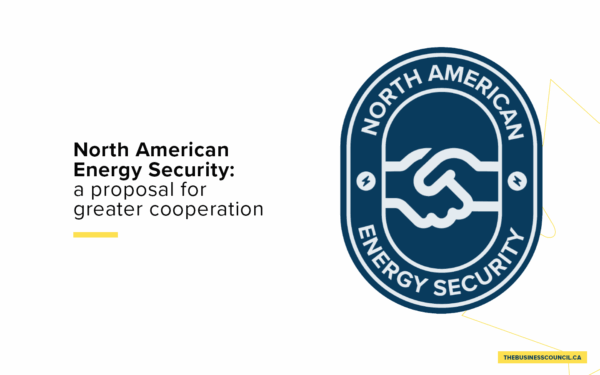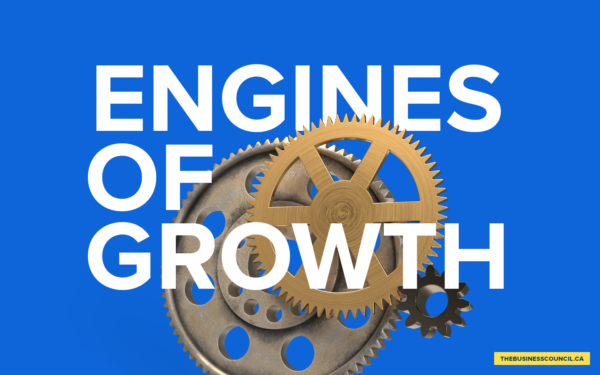Annual Report 2016/2017
People. Community. Collaboration
About the Council
Founded in 1976, the Business Council of Canada is the senior voice of Canada’s business community, representing 150 chief executives and leading entrepreneurs in all sectors and regions of the country. Member companies employ 1.7 million Canadians, account for more than half the value of the Toronto Stock Exchange, contribute the largest share of federal corporate taxes, and are responsible for most of Canada’s exports, corporate philanthropy, and private sector investments in research and development. Through supply chain partnerships, service contracts and mentoring programs, Business Council members support many hundreds of thousands of small businesses and entrepreneurs in communities of all sizes across Canada.
Message from the Chair
“One of the unique strengths of the Business Council is its ability to bring together CEOs and entrepreneurs from across Canada and every sector.”
Linda Hasenfratz

No matter what you make, sell or service, if you are running a large company these days you are thinking – obsessing isn’t too strong a word – about the impact on your business of digital transformation, artificial intelligence and machine learning.
These technologies, at the core of innovation in so many areas, are having a profound effect on almost every industry, enabling us to design new products and services and produce them more efficiently.
Over the past 20 years, the mass adoption of digital devices has revolutionized not only the creative industries – publishing as well as music, film and video production – but also telecommunications, retailing and financial services.
A similar wave of change is now hitting other industries, from natural resources to manufacturing, transportation and construction. Connected sensors provide vast amounts of data that can be tracked, analyzed and acted upon. We are managing our production facilities more effectively, predicting outcomes more reliably, creating bespoke solutions for every problem, and bringing individualized solutions to the mass market. Some call it the Internet of Things (IoT), while others refer to the Fourth Industrial Revolution or Industry 4.0. It translates into every industry intersecting with the tech sector, every company becoming a tech company.
My colleagues and I at the Business Council are experiencing this transformation in real-time. To succeed, we need to harness technology in ways that unlock value for our customers and new growth opportunities for our enterprises. One of the unique strengths of the Business Council is its ability to bring together CEOs and entrepreneurs from across Canada and every sector. We get together three times a year to share experiences, exchange insights and hear from leading thinkers about the challenges facing our companies – and our country.
In the fall of 2016, we met in Alberta to deepen our understanding of the energy sector. We saw how technology is driving down costs and dramatically improving environmental performance in the oil sands. And we visited a pipeline control centre where engineers are managing state-of-the-art monitoring technology with incredible precision. In January, we toured a new automotive software design centre near Toronto. The next morning we sat down to discuss how the age of intelligent machines promises to transform manufacturing.
Then, in April 2017, we met in Waterloo, birthplace of hundreds of technology startups and home to some of the world’s top math, science and engineering talent. As this report went to press, we were preparing for two more meetings that will give Canadian business leaders unparalleled exposure to ideas and technologies that are changing our world. In Palo Alto, California, in late 2017 we will sit down with the heads of some of the world’s most influential tech giants for briefings on what’s coming next and how it will affect our businesses. This will be the largest delegation of Canadian chief executives ever to visit Silicon Valley at one time. Then, in early 2018, we will fly to Munich to see how some of Europe’s most dynamic enterprises are seizing new technologies to reinvent themselves.
This series of meetings represents a once-in-a-generation chance for Canada’s business leaders to gain a window on the future and exchange ideas with key innovators who are helping to design it.
As Canadians we need to take a leadership role in embracing digital transformation to create enormous new value and ensure that our organizations stay globally competitive. My colleagues and I in the Business Council I look forward to the challenge of building a stronger, more successful and more innovative Canada.
Linda S. Hasenfratz, Chair

Message from the President and CEO
“We at the Business Council have been proactive in building the case for the importance of NAFTA and reaching out to our U.S. partners, including at the level of individual states and congressional districts.”
The Honourable John Manley,
P.C., O.C.

As of November 2016, Canada’s relationship with the United States, and the future of the North American Free Trade Agreement, surged to the top of our Business Council agenda. The Canadian government took seriously Donald Trump’s frequent assertions on the campaign trail that NAFTA was “the worst deal ever” – and rightly so. Even before election day, it was obvious that support for NAFTA in Congress was weak. But the new President’s full-throated attack on the architecture of North American trade was new and potentially damaging to Canadian (and American) interests. The Business Council has worked closely with the Government of Canada, as well as with other Canadian groups and our U.S. counterparts at the Business Roundtable, to manage this issue.
At the time of writing we still do not know in detail what the U.S. Administration expects to achieve from the proposed renegotiation. But there are several items that deserve to be on Canada’s wish list. The Trans-Pacific Partnership (TPP) talks, which wrapped up in 2015, produced a number of chapters that could serve as the basis for NAFTA modernization. They deal with everything from electronic commerce and intellectual property to competition rules and the treatment of state-owned enterprises.
In addition, all three countries should see the merit in streamlining NAFTA’s rules-of-origin provisions, which determine whether a good imported from one NAFTA country into another is eligible for duty-free treatment. At a minimum, it makes sense to eliminate the complex tracing requirements that drive up costs and erode the competitiveness of North American companies relative to their international competitors. Here again, the TPP offers a useful template, with rules that are far simpler and easier to administer.
Some U.S. demands may prove challenging for the Government of Canada. Calls by other countries to dismantle Canada’s system of supply management for dairy and poultry are always sensitive politically. I have long believed that this system serves no-one’s interests except those of a small number of farmers and bureaucrats. But the truth is that no country, including the United States, has clean hands when it comes to agricultural subsidies. If the federal government lacks the ambition to free Canada from this system by compensating farmers for the quota they hold, it will almost certainly have to increase duty-free quotas for U.S. producers – the same approach it took in both the TPP and Canada-EU trade negotiations.
There are some areas where Canada must stand firm. A prime example is NAFTA’s Chapter 19, which established a system for independent, bi-national reviews of alleged “unfair” trade cases. In the absence of a robust dispute-settlement mechanism, Canadian exporters would be left to the mercy of the U.S. Commerce Department acting as prosecutor, judge and jury – subject only to appeals to U.S. courts that are not specialized in the intricacies of trade law and whose impartiality will be suspect.
I have no criticism of the Trudeau government’s handling of the Canada-U.S. relationship since the 2016 election, or of their willingness to listen to business concerns and interests. We at the Business Council have been proactive in building the case for the importance of NAFTA and reaching out to our U.S. partners, including at the level of individual states and congressional districts. In the coming year we will continue to dedicate concentrated resources to the preservation of this allimportant – and mutually beneficial – trading relationship.
The Honourable John Manley, P.C., O.C., President and CEO

Year in Review
Economic and fiscal policy
The Business Council of Canada believes that the primary goal of economic and fiscal policy should be to promote growth and economic opportunity for all citizens. To that end, governments must establish the conditions in Canada for global economic success, paying close attention to our country’s ability to compete internationally for jobs and new investment.
Over the past year, the Council has urged the federal government to adopt a laser-like focus on competitiveness as the key to ensuring a better future for Canadians. In a February 2017 letter to Prime Minister Justin Trudeau, we pointed out that combined federal-provincial corporate tax rates in Canada are now higher than in most other advanced countries. Canada’s competitiveness will be further squeezed if the new U.S. Administration follows through on promises to cut corporate taxes and simplify the regulatory environment. “A comprehensive plan to both broaden the tax base and reduce corporate and personal tax rates,” we said, “would strengthen Canada’s ability to attract and retain investment and talent.”
Like competitive tax rates, high-quality public infrastructure influences where individuals choose to work and where companies choose to do business. In its pre-budget submission to Finance Minister Bill Morneau, the Business Council welcomed the federal government’s planned long-term investments in infrastructure spending, including through the creation of the new Canada Infrastructure Bank. We reiterated our view that governments should prioritize projects that will facilitate increased trade and improve productivity, such as ports, railways, roads and airports. Meanwhile, the federal government could spur additional private-sector infrastructure investment by providing the resources required to ensure timely and efficient regulatory consultation and approval processes.
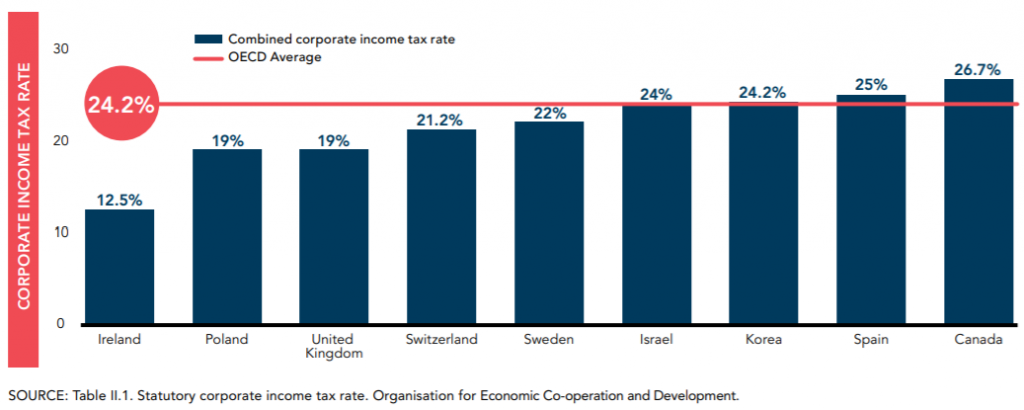
Trade and investment

Protectionist sentiments are on the rise around the world – a clear threat to trade-dependent countries such as Canada. Since 2008, according to the World Trade Organization, G20 governments have introduced 1,583 new trade-restricting measures and removed just 387. Partly as a result, world merchandise trade volumes increased just 1.3 per cent in 2016, one of the weakest performances in many years.
In the face of these challenges, the Business Council has actively promoted new agreements to liberalize trade and investment flows with major and emerging economies. A significant achievement in 2016 was the signing of the Comprehensive Economic and Trade Agreement between Canada and the European Union, the world’s largest and wealthiest single market.
The Business Council’s Canada-China Advisory Group, composed of members with active business interests in and knowledge of the Chinese market, is now providing support to the federal government as it weighs a comprehensive trade agreement with China.
Other priorities include:
- Resuming and concluding bilateral trade talks with Japan and India;
- Launching negotiations with the Association of Southeast Asian Nations, a regional economic cooperation pact involving 10 Southeast Asian nations; and,
- Ensuring that Canada remains actively engaged in the Trans-Pacific Partnership despite the Trump Administration’s decision to pull out.
North America
Canada and the United States share the world’s largest and most comprehensive commercial partnership, supporting millions of jobs in each country. The future of that relationship, however, cannot be taken for granted given the election of President Donald Trump and the strength of the anti-trade lobby in Washington. The Business Council chose to view the President’s call to renegotiate NAFTA as both a threat and an opportunity. Canadians must work hard to protect existing cross-border supply chains and mutually beneficial business relationships – but we should also seize the opportunity to modernize NAFTA, particularly in the areas of digital trade, e-commerce, customs procedures and labour mobility.
Recognizing the truth of the adage that “all politics is local”, the Council has identified congressional districts in rust-belt states with significant trade and investment ties to Canada. The objective is to make sure that individual Members of Congress understand Canada’s importance as a customer of, and investor in, their own districts. Throughout 2017 representatives of Canadian-based companies will meet with Senators and members of the House of Representatives to emphasize the extent to which jobs and economic activity in their states and districts depend on a healthy Canada-U.S. partnership.
In May 2017, the Business Council outlined its priorities for the NAFTA renegotiations in a letter to Prime Minister Justin Trudeau. It emphasized that any new agreement “must be based upon reciprocal access and treatment” and that future disputes related to NAFTA provisions must not be decided by domestic courts: “This was a deal breaker for Canada in the original NAFTA negotiations and it should remain so.”
Energy and the environment
Our country’s bountiful natural resources – including oil, natural gas and other energy sources – offer enormous economic opportunity for all Canadians, provided they are developed in an environmentally responsible manner. The Business Council supports a credible, transparent and efficient review process to ensure that major energy and resource projects do not threaten human health, nearby communities or the rights of Indigenous peoples. We believe in the importance of early engagement with affected parties, and we have advocated for expanded public access to critical information about individual resource projects.

However, we disagree with the view of a vocal minority of critics who have called for a major overhaul of existing environmental assessment agencies and processes. We have urged the government to implement reforms that reduce uncertainty, clarify roles and responsibilities, reduce overlap between federal and provincial processes, and avoid unnecessary delays.
As the federal government continues to debate the future of the National Energy Board and the Canadian Environmental Assessment Agency, we will insist on a process that provides clarity and predictability to Canada’s leading resource developers. Businesses and investors need to know that governments are capable of reaching objective, fact-based and timely decisions on proposed projects. Failing that, Canada risks losing major investments – and the associated employment, government revenue and technology development – to other countries. In the months ahead, the Council will work with like-minded business organizations in support of responsible legislative and regulatory reform.

For more than a decade, the Business Council has endorsed a national price on carbon as an effective tool to align energy and economic development with Canada’s environmental objectives. Amid an emerging patchwork of provincial carbon-pricing schemes, the federal government has vowed to impose a national floor price of $10 per tonne of greenhouse-gas emissions in 2018, rising to $50 in 2022. Meanwhile, the future of climate policy in the United States is much less certain. It will be important to ensure that Canadian companies are not put at a significant disadvantage to their competitors in the United States. We have long argued that carbon-pricing revenues should be used to reduce other taxes and help companies deploy innovative technologies that improve economic and environmental performance.
Corporate and public governance
Diversity in the workplace and on boards of directors can be an important reflection of a company’s values. It can also reduce the risk of “group think” and give boards insight into the needs of customers, investors and other stakeholders. The Council endorses the Ontario Securities Commission’s gender equity “comply or explain” policy, which encourages listed companies to report on the gender composition of their boards and to develop a gender diversity policy for the recruitment of directors and senior management. We will continue to work with governments and other groups to develop voluntary tools and metrics that encourage businesses of all sizes to increase gender diversity in the workplace and on boards.

Proposed amendments to the Canada Business Corporations Act would require directors of public companies to be elected by a majority of shareholders – and force defeated directors to resign immediately. We expressed concern that this is at odds with the policy of the Toronto Stock Exchange, which allows defeated directors to retain their positions for a suitable grace period. The Council believes that boards need time to identify and recruit new directors, and that forcing directors to step down immediately could disrupt company operations.
The Business Council has for several years encouraged the federal government to expand its arsenal of enforcement tools to deter corrupt business practices. We believe that the use of deferred prosecution agreements (DPAs) creates a powerful incentive for companies to self-report wrongdoing and to cooperate with authorities. DPAs help ensure that guilty parties are discovered and prosecuted, while reducing potential harm to innocent employees and shareholders. Several other OECD countries – including the United States and the United Kingdom – use DPAs, which leaves Canadian firms at a competitive disadvantage. Indeed, some Canadian companies have lost valuable contracts abroad because foreign competitors have been able to impugn their integrity while corruption charges are pending. The issue has been studied at length and we have urged the federal government to act without further delay.

Innovation and competitiveness
The Business Council and its member companies have been actively engaged with the federal government as it develops and implements an “inclusive innovation agenda” that will help accelerate business growth and propel entrepreneurs from the start-up phase to international success. In an October 2016 letter to the Minister of Innovation, Science and Economic Development, The Honourable Navdeep Bains, the Council outlined three priorities:
- Build the world’s most talented workforce;
- Foster collaborative partnerships involving business, research institutions and post-secondary researchers; and
- Make it easier for small companies to access the capital they need to grow and attain scale.

One key way that the government has responded is through its announcement in Budget 2017 that it plans to recognize and support three to five industry-driven clusters, investing up to $950 million over five years. Studies show companies that participate in such clusters – geographically concentrated groups of firms and research institutions operating in a particular sector – tend to be more innovative and therefore more productive and competitive. An example is the demonstrated ability of the Toronto-Waterloo Tech North Corridor to attract top talent while also accelerating economic growth in the region. The Business Council will continue to work closely with governments as these clusters take shape.
Jobs and skills

President and Vice-Chancellor,
University of Calgary
Canada is home to a well-educated and skilled workforce, world-class academic institutions and immigration policies designed to attract top global talent. In the past, however, there were relatively few strong talent-development partnerships between business and educational institutions. To help remedy that, in 2015 the Council created the Business/Higher Education Roundtable (BHER), a unique body that brings together the heads of some of Canada’s top companies and post-secondary institutions. Its goals are to assist young Canadians as they transition from school to work, to strengthen Canada’s research capacity, and to help Canadian employers adapt to the economy of the future.

Chair of the Board,
OpenText Corporation
With an equal balance of business and post-secondary leaders, BHER represents major sectors of the economy, regions of the country and the diversity of Canada’s higher education community. Three co-Chairs (left) provide strategic direction, establish BHER’s vision and spearhead its initiatives.
BHER is committed to developing fresh approaches to the changes now taking place at the crossroads of business, education and employment. Collectively, the organizations it represents educate hundreds of thousands of students in diverse programs and employ millions of Canadians in a broad range of industry sectors.

President, George Brown College
BHER is currently focused on increasing the availability of work-integrated learning opportunities for students in key sectors, while also addressing specific, industry-identified skills gaps. (For details, see “Opportunities to succeed”, pages 18-23.)


Opportunities to Succeed
Three weeks after finishing his first year in mechanical engineering at Queen’s University in Ontario, Neil Pandya was in a remote area of northeast Alberta at Cenovus Energy’s Christina Lake oil sands project. “I was nervous,” he remembers. “I was 19, with a week of safety training and eight months of introductory engineering courses, but this was my first exposure to engineering in the real world.” Naturally, he had lots of questions. “Some things aren’t covered in 8:30 a.m. lectures. Why are you putting valves in these locations? What do these instrumentation values stand for? How does this fit into the broader business model?”
By the time his four-month work placement wrapped up, Pandya had moved on from asking questions to answering them. “When I came back after another year of engineering classes, I brought what I learned back to Cenovus. That summer I drove across Alberta, visiting 10 sites and developing a tracking system to monitor flared and vented natural gas.”
Now a full-time operations engineer at Cenovus, Pandya is a beneficiary of work-integrated learning (WIL) – an umbrella term for co-op placements, internships and other programs that combine classroom theory with practical on-the-job experience. Over the past few years, WIL has become a hot topic on Canadian campuses and among corporate recruiters. Spurred by rising demand for work placements, employers and educational institutions are working to increase the supply of WIL programs – a trend that seems likely to accelerate thanks to an innovative partnership conceived and launched by the Business Council of Canada.

The growing interest in work-integrated learning is not hard to understand. Students who participate in WIL programs say the combination of theoretical learning and practical experience helps them develop skills, explore career options and demonstrate their capabilities to potential employers. For their part, companies that offer WIL placements say they do in part because it gives them a chance to assess the skills and suitability of students before they graduate. By contributing to graduate employability and workplace readiness, WIL also allows employers to play an important role in developing the workforce of the future.

Dave McKay, President and Chief Executive Officer of the Royal Bank of Canada, is one of many Canadian business leaders who understand the benefits of WIL for students, educational institutions and employers alike. In the early 1980s, he was a young computer science student at Waterloo University in Ontario. A co-op work term at RBC, he says, “opened my eyes to a world that involved strategy, people and the finance I was studying, and I never looked back.”
Today, McKay is a passionate believer in the power of WIL to prepare students for successful careers. On top of that, he says, WIL helps to bridge the gap between employers and post-secondary institutions. It also improves labour-market access for people from disadvantaged communities who don’t have the necessary social networks to help them get jobs. “Rightly or wrongly, one’s first big job often depends on who you know,” he wrote in a 2016 article for The Globe and Mail. “Work placements get students in front of employers and act as a social leveller.”
By the numbers:
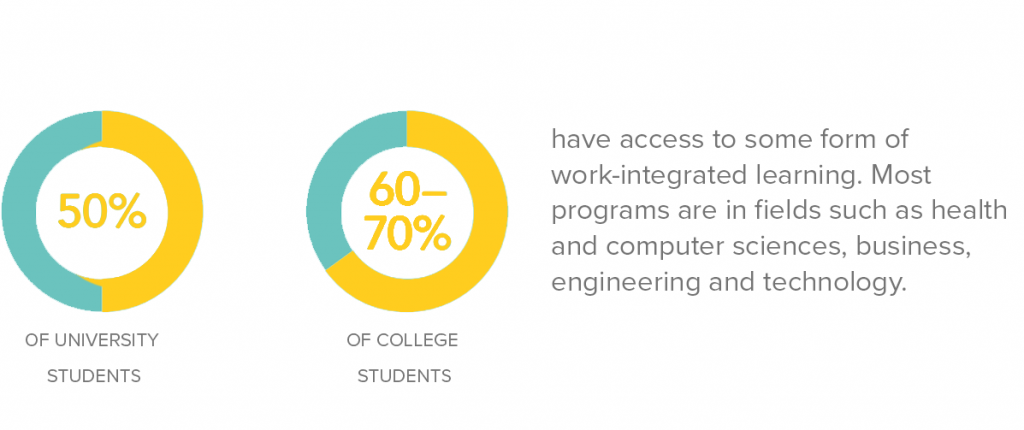
In 2013, under the leadership of then-Chair Paul Desmarais, Jr., the Business Council launched a multi-year research and advocacy initiative called “Taking Action for Canada: Jobs and Skills for the 21st Century.” One of its key goals was to find ways of helping young Canadians transition successfully from school to work – an objective that, by implication, required closer cooperation between employers and post-secondary institutions. To that end, in 2015 the Council announced the creation of the Business/Higher Education Roundtable, a national body representing some of the country’s leading companies and schools from coast to coast.
Over the past year, the Business/Higher Education Roundtable has spearheaded a series of initiatives to bridge the classroom and the workplace. The goal: to provide hands-on learning and career-boosting opportunities for students, while helping Canadian companies stay competitive in the global economy.
Currently, an estimated 60 per cent of Canadian post-secondary students participate in some form of meaningful work-integrated learning experience before graduation. The Roundtable wants to increase that to 100 per cent. In October 2016 it published a report that focused on seven main types of WIL, ranging from apprenticeships (in which most learning is done in the workplace) to applied research projects that students pursue at school but in conjunction with an industry or community partner. The report set out a series of best practices for WIL programs as well as
recommendations to ensure their success.
For the Roundtable and for other proponents of high-quality, work-related learning opportunities, a major milestone was the launch in April 2017 of an ambitious pilot project to create 10,000 new WIL placements by 2020 with some of Canada’s leading banking and insurance companies. The Toronto Financial Services Alliance is overseeing the project – called ASPIRE – with support from 10 major employers and seven Ontario colleges and universities. “This is very much an investment in our future,” explains RBC’s Dave McKay, who helped lead the charge for ASPIRE as head of the Roundtable’s work-integrated learning task force.
“Canada’s major banks and financial-service companies are lining up behind an initiative to ensure that every post-secondary student has a work-integrated learning experience before they graduate, hoping the strategy will create a pipeline of work-ready employees.”
The Globe and Mail, April 19, 2017

Over the coming year, Business Council members will be laying the foundations for similar pilot projects in other regions and other industries, including construction, mining, advanced manufacturing and aerospace. Step one in each case is to identify a high-profile CEO who can act as champion for the program. Step two is to find a partner organization that understands the industry and can work with different stakeholders to deliver the program. Step three is to create an advisory group of experts from the public and private sectors to develop a program that meets the needs of students, post-secondary institutions and employers.
Although it’s still early days, the business leaders who have stepped up to help create more WIL opportunities are optimistic about their ability to succeed. “If we act in a coordinated fashion, the potential scale is really quite profound,” says Roundtable member Tom Jenkins, Chair of OpenText Corporation. “Canada’s business leaders understand the value of investing in young Canadians, and are rising to the challenge.”
By the numbers:

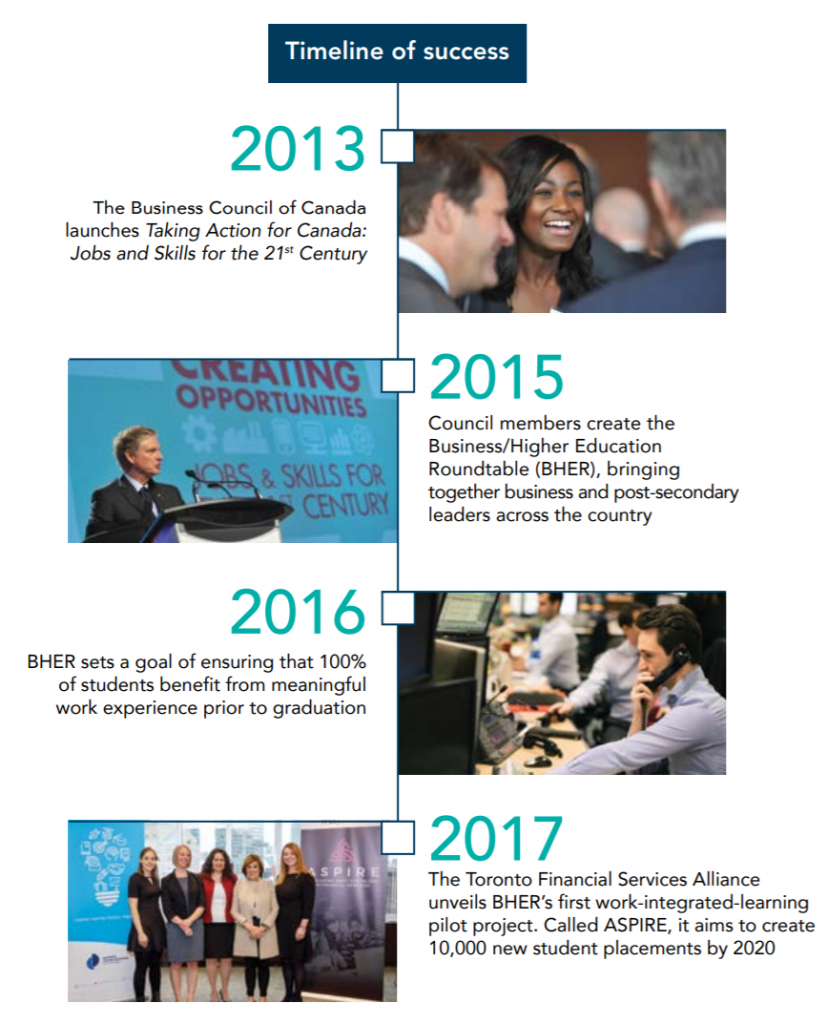
“I chose this program in part because it had so many ties to industry and new technologies.”
Mike Robinson
After years as a jazz musician and music teacher, Mike Robinson enrolled as a co-op IT student at Nova Scotia Community College. In his first year, he placed in the top one per cent among 4,000 competitors across North America in IBM’s “Master the Mainframe” contest, which promotes enterprise computing and coding skills. Mike then spent a summer working for IBM before returning to the classroom. “IBM tells us that part of the value of these challenges and co-ops is finding people who think outside of the box, who work in a feedback loop of learning, testing, trying and learning again,” he says. “I’m excited to start school with a new breadth of knowledge.”

Making a Difference
For many people, the words “corporate philanthropy” conjure up images of dark-suited executives handing over giant cheques to charitable causes.

To be sure, Canada’s leading companies do give generously to a wide variety of charities and community groups. But corporate philanthropy comes in many other forms too, from encouraging volunteers and mentoring new immigrants, to organizing sports and fitness events across the country.
A 2008 survey by Imagine Canada, a national charitable organization, found that 76 per cent of all Canadian businesses donate money to nonprofit groups. But among larger firms — those with revenues of $25 million or more — the rate was 97 per cent. The same study found that two-thirds of large companies match their employees’ donations dollar-for-dollar, compared with nine per cent of the wider business community. And three in every four large firms give their staff paid time off for volunteer work, compared to fewer than half of all businesses.
The following pages highlight some of the many ways Canada’s largest companies give back to the communities that have made their success possible.
In 2010, the U.S.-based Association of Fundraising Professionals named TELUS the world’s most outstanding philanthropic corporation – the first Canadian company to receive this honour.
Volunteering
In a typical year, more than 12 million Canadians perform some form of volunteer work. Large employers across the country have harnessed this enthusiasm to organize and support a vast array of worthy causes.

TELUS is widely recognized as a leader in volunteering. The company estimates that its employees and retirees have given seven million hours of their time and raised $440 million for charities and non-profit organizations since 2000.
Guided by the motto, “We give where we live”, TELUS matches staff donations to more than 50,000 registered Canadian charities. Any employee or retiree who performs 50 hours of volunteer service can direct a $200 donation to a charity or non-profit sports organization of his or her choice.
The company also organizes “days of giving” each year. Volunteers help hundreds of groups with activities that include serving breakfast to the homeless, compiling tactile books for blind children, escorting disabled adults to community events, and cleaning up parks and public spaces.
Power Corporation
“We believe that strong communities create strong businesses,” says Paul Desmarais, Jr., Chairman and co-CEO of Montreal-based Power Corporation of Canada, whose holdings include Great-West Life, Investors Group and several other leading Canadian financial services companies.
Power has supported more than 800 charities and non-profit organizations in fields as varied as Paralympic sports, helping students with homework assignments, and protecting Mount Royal, one of Montreal’s most recognizable landmarks.
Almost a quarter of Power’s community spending in 2016 was earmarked for arts and culture. Power and its subsidiaries were the largest private-sector contributors to the Canadian Museum for Human Rights in Winnipeg. Among other institutions that have benefited from Power’s generosity are The National Theatre School of Canada in Montreal, the Banff International Literary Translation Centre, the National Music Centre in Calgary and the Glenn Gould Foundation in Toronto.
Sports and fitness
Philanthropy often encompasses activities that promote a fit and healthy lifestyle. Business Council members are prominent supporters of events that raise money for the treatment of harmful or terminal diseases.
The CIBC Run for the Cure is an annual run or walk that raises money for the Canadian Breast Cancer Foundation. The event, which draws more than 100,000 participants across the country, has raised more than $17 million since its inception in 1992.
In Alberta, Ontario and Quebec, Enbridge sponsors the annual Ride to Conquer Cancer, a two-day, 200-km endurance test. The ride has raised more than $250 million since 2008 for Toronto’s Princess Margaret Cancer Centre, recognized as a world leader in cancer research and treatment.
Scotiabank sponsors annual marathons in six cities, from Halifax to Vancouver. The events have raised more than $50 million for 550 charities since the challenge began in 2003. The Scotiabank Toronto Waterfront Marathon alone raised $3.2 million for 182 charities in 2016.
Canadian Tire
There’s nothing like teamwork to teach children valuable life skills such as discipline, confidence and compassion. That’s part of the thinking behind Canadian Tire’s Jumpstart charity, which gives thousands of underprivileged kids across the country a chance to take part in organized sport and physical activities.

For example, Jumpstart’s “Big Play” program, launched in 2015 in partnership with the Hockey Canada Foundation, aims to get 30,000 children on the ice as members of a hockey team by the end of 2017.
Besides team sports such as hockey, soccer and baseball, Jumpstart funds a long list of activities for kids, from archery to yoga. Applications are reviewed by Canadian Tire employee volunteers and local community groups in 330 chapters across Canada.
Canadian Tire and its affiliated retail chains, including Mark’s, Sport Chek and Gas+, organize a Jumpstart month each spring, encouraging customers to donate as they shop. The company itself covers all of the charity’s administration costs, which means that every penny of customers’ donations go directly to help kids in need.
Bell Canada
An average of 11 people commit suicide every day in Canada – a shocking statistic that underscores the toll mental illness takes on society. Mental illness also lies behind almost a third of all workplace disability claims and 70 per cent of disability costs.

Since its inception in 2011, Bell Canada’s annual Let’s Talk Day has raised $87 million for mental health initiatives. As well as helping to alleviate the stigma of mental illness, the campaign supports more than 600 treatment, care and research organizations across the country, from big hospitals and universities to small community groups.
On Let’s Talk Day, Bell donates five cents for every text message, mobile call and long-distance call made by its customers. Social media posts that use the #BellLetsTalk hashtag trigger similar donations. For the past three years, #BellLetsTalk has been a top-trending Twitter hashtag worldwide – proof of Bell’s success in turning a corporate philanthropy initiative into a true cultural phenomenon.
Fort McMurray fire
The fire that swept through Fort McMurray, Alberta, in May 2016 destroyed thousands of homes and buildings. More than 80,000 residents were forced to flee the city, causing widespread disruption to schools, businesses and day-to-day life. The fire is reported to have been the costliest natural disaster in Canada’s history.
Business Council members across the country were quick to offer help when disaster struck, and have remained involved as local residents rebuild the city and their lives.

Oil sands producers, such as Suncor Energy and Shell Canada, provided temporary accommodation at nearby camps for thousands of evacuees. ATCO donated 10,000 meals to firefighters and other emergency responders, and offered shelter to evacuees at two nearby lodges. Canadian Pacific donated $100,000 to the Red Cross and, like many other companies, matched donations from its employees.
Since the fire, Suncor has continued to work closely with non-profit community organizations in the area, including Social Prosperity Wood Buffalo and Fuse Social. The Suncor Energy Foundation donated $1.4 million to recovery efforts in Fort McMurray in 2016, plus ongoing support in 2017. With the help of a text-to-donate program, TELUS and its customers contributed $1.2 million in support of relief efforts.
On the other side of the country, EllisDon teamed up with sub-contractors and developers in Nova Scotia to organize a golf tournament. The event raised $50,000 for the Canadian Red Cross Alberta Fire Relief fund.
Beyond Canada’s borders
The philanthropic efforts of Canada’s leading companies do not stop at Canada’s borders. Many have far-flung international operations where they actively encourage managers and employees to lend a helping hand in local communities.

Barrick Gold, the world’s top gold producer, employs 14,000 people at mines in nine countries outside Canada. Barrick’s Pueblo Viejo project in the Dominican Republic provides work for 2,000 people and has spawned more than 200 new local companies, while generating 45 per cent of the nation’s corporate tax revenues since it opened in 2013. A community partnership, one of many, has brought Internet access and technology to more than 600 students and 50 teachers in schools near the mine.

Half a world away, Royal Bank of Canada employees organized and took part in a five-kilometre family fun run around Queen Elizabeth Olympic Park in London in 2016 to raise funds for Great Ormond Street Hospital,
one of the world’s premier children’s hospitals. The event was part of the RBC Race for the Kids, held each year in a dozen cities around the world, including Hong Kong, New York and Sydney. The races support RBC Kids Pledge, a five-year, $100 million program to improve the well-being of one million youngsters around the world.
A Manulife subsidiary in Indonesia gives high priority to promoting
financial literacy. It has partnered with a local news channel to build
Studio Metro Manulife which focuses on educational programming. By
2015, Gaya Hidup Masa Depan (Future Lifestyle) had broadcast more
than 110 episodes, while Cerdas 5 Menit (Being Smart in Five Minutes)
had produced 550 segments.

Elsewhere in Asia, Manulife supports Urban Angels, an annual medical mission to the Visayas region of the Philippines organized by St. Michael’s Hospital in Toronto. Volunteers of Urban Angels provide medical consultations, ophthalmic surgeries and physiotherapy to local residents. In a single week in 2015, they completed nearly 4,000 check-ups, 200 eye exams and 40 surgeries. Other volunteers distributed more than 8,700 spectacles to residents of Toledo and Bacolod City. Manulife employees fluent in the regional dialect act as translators for the Canadian doctors, Manila-based volunteers and local patients.
Syrian refugees
Canadians have earned widespread praise for welcoming more than 40,000 Syrian refugees since November 2015. Businesses across the country have played a significant role in resettling the new arrivals and helping them transition to life in Canada.
Shortly after the federal government launched the resettlement initiative, Manulife donated $500,000 to a fund that helps refugees with transitional housing, language instruction and skills training. Canadian National Railway subsequently chipped in $5 million. General Motors Canada and HSBC Bank Canada also contributed to the fund, providing support through local charities in 27 communities. For its part, Air Canada flew thousands of Syrian families to Canada. Its employees then raised $57,000 for refugee programs, with donations matched by the Air Canada Foundation.
Cenovus

Active and respectful engagement with indigenous communities is a high priority for many of Canada’s large companies. In practice, that can mean buying products and services from indigenous entrepreneurs, providing investment and social funding, and supporting local employment and training programs.
Calgary-based Cenovus is a leader in indigenous engagement. It has signed long-term agreements with nine communities near its oil sands projects. Cenovus officials make a point of meeting with each community several times a year to discuss local concerns and ensure the company is living up to its commitments.
In addition, Cenovus sponsors a range of specific programs for indigenous communities. It offers up to 10 new $3,500 scholarships a year for students who are pursuing a post-secondary degree, diploma or trade. It also supports Cree language and cultural classes for local youth at the Bigstone Cree Nation’s Kapaskwatinahk cultural educational centre in northern Alberta.

Factories of the Future
Think “manufacturing” and what comes to mind? A large factory full of clanging machines? Brawny workers in overalls performing repetitive tasks? Increasingly, the modern face of manufacturing looks more like the new General Motors of Canada technology centre in Markham, Ontario, just north of Toronto.
Wander around inside and you’ll see casually dressed men and women in their 20s and 30s peering into computer screens, sipping coffee and tapping out lines of computer code. Clusters of white modular desks are interspersed with designer sofas and open-concept meeting areas. Large windows let in plenty of sunlight, creating a bright and airy workspace.
No, traditional factories haven’t disappeared. But manufacturing is changing, driven by shifts in consumer demand and breakthrough technologies such as 3D printing, advanced robotics and artificial intelligence. In the era of advanced manufacturing, new concepts and ideas are powering smarter, leaner factories. Computer-driven tools allow companies to create prototypes and ramp up to full production at speeds that were once unimaginable.
The products themselves are changing, too. In many cases, the physical properties of an object matter less than the software and cloud-based services that allow digitally enabled products to deliver value to the customer.
At GM’s new Markham facility, for example, the focus is on developing advanced systems for future generations of autonomous and Internet-connected cars. “We’re excited to be giving Canada’s best and brightest software engineers opportunities to help define some of the most important mobility technology changes in a generation,” says Stephen Carlisle, GM Canada’s President and General Manager.
GM’s decision to invest in the facility – and to hire 700 new highly skilled employees – is in part a testament to the quality of Canada’s education system and labour force. “Canada’s focus on innovation, talent development and partnerships with the academic sector all bode well for the future,” Carlisle says.

Paul Boothe, a former senior federal public servant who now runs the Trillium Network for Advanced Manufacturing, says there are encouraging signs of growth in Canada’s manufacturing sector after a long period of decline. Between 2000 and 2009, real manufacturing output in Canada fell by 22 per cent and exports by 40 per cent. In contrast, between 2009 and 2015 output rose by 13 per cent and exports by 35 per cent.
Those numbers may actually understate the extent of the turnaround, since they don’t include a wide range of services –from software development to accounting, legal services and marketing – that make up an increasing share of manufacturing activity. “In some manufacturing industries, more than half of all employees work in service roles, such as R&D engineers and office-support staff,” a recent McKinsey & Company study found.
One thing is certain: over time, manufacturing has become more knowledge-intensive and less reliant on low- or semi-skilled manual labour. That’s potentially good news since it plays to Canada’s strengths as an advanced economy with one of the world’s highest post-secondary graduation rates.
Still, success is far from guaranteed. To survive and thrive in the face of intense international competition, companies need a strong commitment to innovation both in the products they create and the processes they use to make those products.
For their part, governments need to embrace the future of Canadian manufacturing as a priority, with policies that enhance Canada’s ability to attract manufacturing investments and win global mandates.
The following pages offer several examples of advanced manufacturing in Canada, as practiced by member companies of the Business Council of Canada.
Brilliant thinking

A “brilliant” factory, in GE parlance, is a state-of-the-art facility that combines lean manufacturing, industrial 3-D printing and advanced software analytics to enhance productivity. Set to open in early 2018, GE’s new 450,000-square-foot industrial gas engine plant in Welland, Ontario, will use advanced manufacturing techniques to combine data science and analytics with more traditional methods of manufacturing. Although the first phase of the plant will focus on producing gas engines, the factory’s secret lies in its ability to quickly pivot into manufacturing other products.
GE operates in more than 180 countries, so the company could have decided to locate the new plant almost anywhere. But in the end, Welland provided to be the ideal location for the $165-million (U.S.) investment. “We’ve had such fantastic support from academic and government resources,” says Elyse Allen, President and CEO of GE Canada. She added that a talented local workforce, robust educational infrastructure, proximity to U.S. markets and available serviced land made Welland the front-runner.
Cool electronics
As Canada’s advanced manufacturing and digital technologies industries heat up, researchers at 3M have an important task: cooling them back down. The electricity consumed by large computer data centres causes thermal buildup, forcing companies to blast equipment with cool air to keep everything at a safe temperature. At 3M Canada’s research and development lab in London, Ontario, researchers created a new type of liquid that works quickly, cleanly and efficiently to put out fires in overheated computer systems. Dubbed Novec 1230, the fluid is non-conductive so it will not damage electronics or paper. It can be used for open bath immersion cooling of servers, reducing the reliance on air conditioners, saving energy and minimizing the size of data centres.


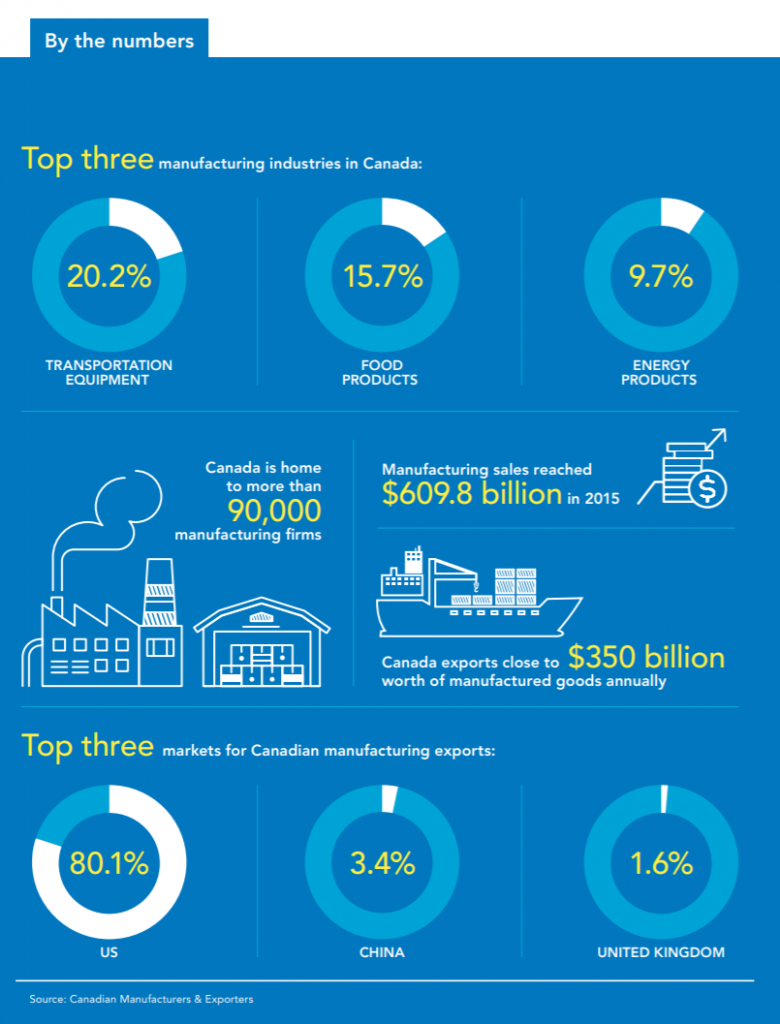
Machine learning
The rise of advanced manufacturing creates increasing demand for employees with the knowledge to design, operate and maintain complex machinery. Siemens Canada recently announced a partnership with British Columbia’s Kwantlen Polytechnic University to teach advanced manufacturing skills and concepts. The result is the new Siemens Mechatronics Systems certification program, offered by the university in association with Siemens’ own Engineering and Technology Academy in Oakville, Ontario.

Mechatronics is the combination of mechanical, electrical and computer software technologies as well as control and systems theory into a single system used in production and manufacturing. Graduates from the program can choose to pursue careers in a wide variety of industries, including aerospace, materials processing, machine building, automotive, transportation, building technologies and mining. “By partnering with Siemens, a world leader in engineering and manufacturing technology education, KPU reaffirms its commitment to a futurefocused, high-quality and globally relevant advanced manufacturing training program,” said Dr. Salvador Ferreras, KPU’s Provost and Vice President Academic.
Clean power

When hydrogen – the most abundant element in the universe – reacts with oxygen it creates heat that can be used to generate clean electricity. That’s the underlying principle behind a hydrogen fuel cell. In Burnaby, B.C., a joint venture between Ford Motor Company and Daimler AG is working to commercialize fuel-cell technology to power zero-emission cars. Established in 2008, Automotive Fuel Cell Cooperation Corp. is a world leader in automotive fuel-cell development, with technology that delivers best-in-class cost, performance and durability. Fuels cells work by converting the chemical energy from hydrogen gas into electricity. With no combustion and no by-products other than heat and water vapour, fuel cell vehicles are two to three times more efficient than today’s most advanced internal combustion engines.
Energizing the workplace
ABB Canada’s new headquarters and research and development centre in Montreal harnesses a range of emerging technologies, including the industrial Internet, artificial intelligence, robotics and clean tech. The $90-million facility consolidates all of ABB Canada’s assembly, manufacturing, research and development and testing under one roof. It also houses the company’s North American Centre for Excellence in e-Mobility, a program that focuses on energy solutions for electric buses and trains.
Canada was a natural choice for this investment, says Ulrich Spiesshofer, ABB’s global President and Chief Executive Officer: “With its excellent universities and associated ecosystem, Canada provides all the right ingredients for research and development needed to develop global technology platforms.” Designed to create an inspiring workplace that inspires innovation, the new campus includes charge stations for electric cars, a gym, bicycle racks, an ultramodern cafeteria and easy access to public transportation.


CEO Summits
Three times a year, the full membership of the Business Council of Canada meets to discuss critical domestic and international issues, the economic outlook, current business challenges and emerging opportunities. These events provide Canadian business leaders with unique opportunities to exchange views with their peers, as well as with senior policymakers, top thinkers and innovators from around the world.
Over the past 12 months, the Council’s meetings have taken place in Calgary, Toronto and Kitchener-Waterloo, Ontario.
Calgary
Energy and innovation were key themes of the Council’s autumn 2017 members’ meeting. Through panel discussions, behind-the-scenes tours of Suncor and Cenovus oil sands projects, and a visit to TransCanada’s operations control centre in Calgary, members heard and saw first-hand how leading energy companies are harnessing new technology to safeguard the environment and reduce greenhouse gas emissions. Separately, David MacNaughton, Canada’s Ambassador to the United States, shared his insights on the race for the U.S. presidency, and Goldy Hyder, President and CEO of Hill+Knowlton Strategies Canada, led a CEO panel on social license and what it means for business. Additional speakers included Alberta Premier Rachel Notley, Canadian astronaut Chris Hadfield, and The Honourable Rona Ambrose, interim leader of the Conservative Party of Canada. A special highlight was a performance of Maestro Roger Nierenburg’s “The Music Paradigm” in Calgary’s stunning new National Music Centre.
Toronto
Close on the heels of President Donald Trump’s inauguration, the Business Council’s first meeting of 2017 was dominated by discussion of the Administration’s policy agenda and the likely consequences for Canada. Newt Gingrich, former Speaker of the U.S. House of Representatives, shared his insights as a Trump adviser, while Ambassador David MacNaughton outlined Canada’s strategy for dealing with Washington. David Rosenberg, Chief Economist at Gluskin Sheff, and Ian Bremmer, President of Eurasia Group, identified some of the key economic and political risks facing business in the Trump era. Over dinner, veteran U.S. journalists Mark Halperin, John Heilemann and Ann Compton discussed the rising tide of populism and its impact on policymaking.

Turning to the theme of innovation, members toured GM Canada’s new technology centre in Markham, Ontario, where engineers are developing software for future generations of self-driving and Internet-connected cars. Later, a CEO panel explored how advanced robotics, artificial intelligence and the “Internet of Things” are transforming Canadian manufacturing.
Kitchener-Waterloo

Prime Minister Justin Trudeau, Governor General David Johnston, and Bank of Canada Governor Stephen Poloz were three of the featured speakers at the Council’s April 2017 meeting in Waterloo, Ontario. The centrepiece of the program, though, was the area’s remarkable innovation ecosystem, which has given rise to the world’s second-highest density of technology start-ups. During a visit to the University of Waterloo – including a lively start-up pitch competition – Council members saw how a commitment to co-op education and hands-on learning has fostered an entrepreneurial culture that is unique among Canadian post-secondary institutions. Members also toured the headquarters of OpenText Corporation, spent an evening at the Perimeter Institute and heard from its Founder and Board Chair, Mike Lazaridis, about Waterloo’s potential as a centre for quantum technology research and commercialization.
The final stop on the program was Communitech, an industry-led centre that supports firms at all stages of growth and development. Panels focused on the role of corporate innovation labs, the rise of corporate venture capital, and how large companies can avoid disruption by partnering with, and learning from, lean start-ups.









